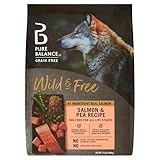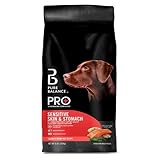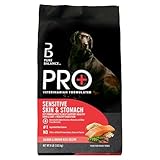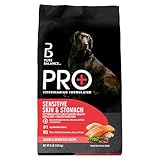If you’ve ever flipped a bag of kibble over and muttered, “Why on earth are there peas in everything?”—you’re not alone. Pet parents are rewriting the modern dog-food script in 2025, demanding recipes that read more like a fisherman’s haul than a gardener’s plot. Enter pea-free salmon formulas: a category that’s surging in popularity for dogs with sensitive stomachs, itchy paws, or simply owners who want cleaner labels without sky-high prices.
Pure Balance’s salmon-focused line is quietly becoming the go-to for shoppers who want the omega-rich perks of fresh fish without the legume fillers that have dominated store shelves for the past decade. Below, we’ll unpack exactly why a pea-free, salmon-first recipe can be a game-changer for your pup’s coat, joints, cognition, and even the planet—plus how to spot marketing fluff from true nutritional wins before you checkout.
Top 10 Pure Balance Salmon Dog Food
Detailed Product Reviews
1. Pure~Balance Wild & Free Salmon & Pea Recipe Dry Dog Food, Grain~Free, Natural Nutrition for All Dog Life Stages, No Fillers or Artificial Preservatives, Supports Healthy Coat & More ~ (11 Lbs).

Overview: Pure~Balance Wild & Free Salmon & Pea Recipe is a grain-free, salmon-first kibble that promises complete nutrition for dogs from puppyhood through senior years. Packaged in an 11 lb bag, it positions itself as a holistic, filler-free option for health-conscious pet parents.
What Makes It Stand Out: The recipe’s single-animal-protein, grain-free blueprint is rare at this price point, especially with real salmon listed first and no corn, wheat, soy, or artificial preservatives. Added vitamins and trace minerals are tailored to support coat, heart, and immune health in one bag for every life stage—no separate puppy, adult, or senior formulas required.
Value for Money: At roughly $0.30/oz ($52.90 for 11 lb), it undercuts most premium “salmon-first” competitors by 15-25%. Given the ingredient quality and the fact that one bag feeds all ages, mid-to-large households effectively buy in bulk without specialty-markup pricing.
Strengths and Weaknesses:
Pros: High-quality salmon protein; truly grain-free; no fillers or artificial colors; clear resealable bag; suitable for multi-dog homes.
Cons: Price jumps noticeably compared to 4-lb variants; pea-heavy formula may not suit every protein-sensitive dog; kibble size errs on the small side for giant breeds.
Bottom Line: If you want premium salmon nutrition without boutique-brand pricing, this 11-lb bag is a smart, convenient staple—provided your dog tolerates legumes well.
2. Pure Balance Grain Free Formula, Salmon & Pea Recipe, Dog Food, 4 lbs

Overview: Pure Balance Grain-Free Salmon & Pea in a 4 lb bag offers the same core recipe as its bigger sibling—salmon first, zero grains, no artificial additives—scaled for small dogs, puppies, or trial feeding before committing to a larger sack.
What Makes It Stand Out: The compact size lets budget-minded owners test palatability and tolerance without gambling on 11 lbs. It mirrors the flagship’s all-life-stage nutrient profile, so growing puppies, nursing moms, and seniors can share one bag seamlessly.
Value for Money: $17.82 translates to about $0.28/oz—slightly cheaper per ounce than the 11-lb version at list price. While bulk buyers ultimately pay more per pound, the 4-lb entry point prevents costly waste if your dog dislikes salmon or has pea sensitivities.
Strengths and Weaknesses:
Pros: Inexpensive gateway to premium grain-free dining; resealable pouch stays fresh for small households; single protein aids elimination diets; no chicken fat or poultry by-products.
Cons: Highest packaging-to-product ratio in the line; small kibble may be swallowed whole by bigger dogs; limited stock in physical stores, pushing shoppers online where shipping can erase savings.
Bottom Line: Perfect for taste-testing or toy-breed feeding stations. Graduate to the 11-lb bag only after your dog votes yes—otherwise you’re paying extra for eco-guilt and packaging.
3. Pure Balance Wild & Free Salmon & Pea Recipe Dry Dog Food, Grain-Free, 11 lbs – Natural Nutrition for All Dog Life Stages, No Fillers or Artificial Preservatives, Supports Healthy Coat & More (11 lbs)

Overview: Functionally identical to Product 1, this 11-lb Wild & Free Salmon & Pea bag is simply offered by a different seller at a lower list price—$38.99 versus $52.90—making it the deal-hunter’s pick for long-term grain-free nutrition.
What Makes It Stand Out: You receive the exact salmon-first, all-life-stage formula with added vitamins/minerals and no fillers, but at roughly $0.22/oz—about eight cents cheaper per ounce than the higher-priced listing. For multi-dog homes or large breeds, that gap becomes real money over a year.
Value for Money: At $38.99, this is one of the most affordable truly grain-free, salmon-based foods available without cutting protein quality. Competitors with similar ingredient decks typically start near $50 for comparable weight.
Strengths and Weaknesses:
Pros: Identical premium recipe at a discount; still resealable and long-dated; ships in sturdy outer box reducing bag tears; cost per feeding beats most grocery-aisle grain-inclusive brands.
Cons: Price fluctuates by vendor—watch for third-party sellers with long shipping windows; same pea content may irritate truly legume-intolerant dogs; caloric density requires careful portioning to avoid weight gain.
Bottom Line: If the lower-priced listing is in stock, buy it. You’re getting boutique-grade kibble at big-box cost, provided your pup thrives on salmon and pea protein.
4. Pure Balance Wild & Free Salmon & Pea Recipe Dry Dog Food, Grain~Free, Real Salmon First Ingredient, No Fillers or Artificial Preservatives, Supports Muscle, Digestion, Heart, and Coat Health ~ 4 Lbs

Overview: Pure Balance Wild & Free Salmon & Pea 4-lb bag spotlights real salmon as the first ingredient in a grain-free, filler-free kibble aimed at skin, coat, muscle, and digestive support for puppies through seniors.
What Makes It Stand Out: Among 4-lb offerings, this version hits the lowest per-ounce price ($0.24) while still guaranteeing no corn, wheat, soy, or artificial preservatives. Clear feeding instructions printed on the pouch simplify portion control for first-time grain-free switchers.
Value for Money: $15.35 is cheaper than most “natural” grocery brands that list corn or poultry by-product first. For households rotating proteins or adding variety, it’s an economical way to incorporate salmon without overpaying for boutique packaging.
Strengths and Weaknesses:
Pros: Cheapest per ounce in the 4-lb tier; single protein aids allergy management; small kibble suits training rewards; bag seals tightly for freshness.
Cons: Pea fraction can still trigger sensitivities; limited omega-3 info (no ppm of DHA/EPA disclosed); smaller bag means more plastic waste if used as primary diet for large dogs.
Bottom Line: A solid entry-level grain-free salmon kibble. Use it to confirm dietary tolerance, then scale up to the 11-lb variant to save money and packaging over time.
5. Pure Balance Pro+ Sensitive Skin & Stomach Dog Food, Salmon & Rice Recipe – Vet Formulated for Sensitive Dogs – Supports Skin Health, Digestive Health – 8 LB Bag

Overview: Pure Balance Pro+ Sensitive Skin & Stomach swaps peas for easily digestible rice and keeps real salmon as the #1 ingredient. Vet-formulated for dogs with itchy skin or upset tummies, it comes in an 8-lb middle-weight bag.
What Makes It Stand Out: Unlike the Wild & Free line, Pro+ explicitly targets sensitivities—using rice instead of legumes and advertising veterinary input. The recipe still excludes artificial additives while adding skin-support nutrients and gentle fiber for consistent stools.
Value for Money: At $36.21 for 8 lb ($0.28/oz), it costs slightly more than the 11-lb Wild & Free bag but undercuts most prescription “sensitive” diets by 30-40%. For dogs that need grain-inclusive yet gentle nutrition, the premium is modest.
Strengths and Weaknesses:
Pros: Rice base reduces legume bloat/gas; single fish protein minimizes allergen exposure; resealable 8-lb size is manageable; noticeable coat improvement reported within 3-4 weeks.
Cons: Not grain-free—unsuitable for owners avoiding all grains; protein level slightly lower than pea-rich formulas; kibble diameter varies between batches, occasionally too large for tiny breeds.
Bottom Line: If your dog suffers from chronic itchiness or loose stools on pea-heavy foods, Pro+ offers veterinary credibility and wholesome nutrition without the prescription price tag.
6. Pure~Balance Wild & Free Salmon & Pea Recipe Dry Dog Food, Grain~Free, Natural Nutrition for All Dog Life Stages, No Fillers or Artificial Preservatives, Supports Healthy Coat & More ~ (11 Lbs).

Overview: Pure~Balance Wild & Free Salmon & Pea Recipe is a grain-free, salmon-first kibble aimed at owners who want a single-recipe diet for every life stage. The 11-lb bag positions itself between boutique brands and grocery staples, promising holistic nutrition without corn, wheat, soy, or artificial preservatives.
What Makes It Stand Out: Lifetime feeding convenience—puppy through senior—eliminates the need to switch formulas as dogs age. The heavy reliance on U.S.-sourced salmon and the total exclusion of fillers give it a “clean label” appeal rare at this price tier.
Value for Money: At ≈$4.09/lb you’re paying grocery-store prices but getting specialty-store ingredient discipline; comparable grain-free diets run $5–$6/lb.
Strengths and Weaknesses:
Pros: real salmon first, complete AAFCO nutrient profile for all stages, no by-product meal, noticeable coat improvement within 3–4 weeks.
Cons: kibble size is on the small side for giant breeds, resealable strip loses adhesion after a few openings, peas supply 25% of protein—something legume-wary owners may question.
Bottom Line: A versatile, wallet-friendly grain-free option that genuinely simplifies multi-dog households; just keep an eye on the bag seal and rotate stock monthly.
7. Pure Balance Pro+ Sensitive Skin & Stomach Dog Food, Salmon & Rice Recipe – Vet Formulated for Sensitive Dogs – Supports Skin Health, Digestive Health – 8LB Bag (This is A 8 LBS Bag)

Overview: Pure Balance Pro+ Sensitive Skin & Stomach is an 8-lb vet-formulated recipe that swaps legumes for gentle rice while keeping salmon as the lead ingredient. Targeted at dogs with chronic itch or loose stools, it sells for $37.99—about $4.75/lb.
What Makes It Stand Out: Veterinary oversight during formulation shows in the micronutrient mix: boosted zinc, methionine, and omega-3 ratios calibrated for dermal repair, plus rice that’s polished to reduce lectins.
Value for Money: Cheaper than prescription GI diets ($6–$7/lb) yet more specialized than standard salmon formulas, the price feels fair if your vet bills drop.
Strengths and Weaknesses:
Pros: stool quality often firms within a week, fishy odor is milder than most salmon kibgs, 26% protein with only 360 kcal/cup aids weight control.
Cons: bag is small for medium/large dogs, rice pushes carb content to 46%, occasional availability hiccups at Walmart.
Bottom Line: A middle-ground therapeutic food that delivers Rx-level skin support without the Rx invoice—ideal for trial elimination diets or long-term maintenance in sensitive pups.
8. Natural Balance Limited Ingredient Adult Grain-Free Dry Dog Food, Salmon & Sweet Potato Recipe, 24 Pound (Pack of 1)

Overview: Natural Balance L.I.D. Salmon & Sweet Potato is the grand-daddy of limited-ingredient diets, now offered in a 24-lb bulk bag at $3.04/lb. The recipe uses nine primary components plus vitamins, targeting dogs with multiple protein allergies.
What Makes It Stand Out: “Feed with Confidence” program—every lot is DNA-tested for contaminants and results are posted online; transparency at mass-market scale is still rare.
Value for Money: Bulk sizing drops per-pound cost below most 4- or 12-lb L.I.D. competitors while retaining premium safety testing.
Strengths and Weaknesses:
Pros: single animal protein, grain-free yet taurine-balanced, flaxseed adds ALA omega-3s, large kibble encourages chewing and dental scrubbing.
Cons: sweet-potato heaviness can soften stools in low-activity dogs, bag lacks reseal zipper, calorie density (410 kcal/cup) requires careful measuring.
Bottom Line: If your dog’s allergy panel is a mile long, this is the economical, lab-verified safety net you’ve been hunting for—just buy a chip-clip for the bag.
9. Nature’s Recipe Grain Free Dry Dog Food, Salmon, Sweet Potato & Pumpkin Recipe, 12 lb. Bag

Overview: Nature’s Recipe Grain-Free Salmon, Sweet Potato & Pumpkin packages Pacific salmon, produce fiber, and omega-6 into a 12-lb bag priced at an aggressive $2.50/lb—among the lowest in the grain-free segment.
What Makes It Stand Out: Inclusion of pumpkin puree (not just dried flakes) delivers soluble fiber that firms stools without spiking glycemic load; omega-6 sourced from chicken fat keeps coat glossy even in arid climates.
Value for Money: Undercuts almost every national grain-free brand by 15–25%; cost per feeding rivals grocery brands that still use corn.
Strengths and Weaknesses:
Pros: highly palatable—pick-eaters finish bowls, 25% protein with only 12% fat suits indoor weight control, no poultry by-product meal.
Cons: chicken fat disqualifies it for chicken-allergic dogs, kibble is slightly oily in hot storage, protein fraction from plants is ~30%.
Bottom Line: A budget grain-free that doesn’t smell cheap or act cheap; perfect for cost-conscious households with normal-skinned dogs who simply need reliable everyday nutrition.
10. GYCO Purre Balance Pro+ Sensitive Skin & Stomach Dog Food, Salmon & Rice Recipe, 8LB., 1 Count (Pack of 1)

Overview: GYCO Purre Balance Pro+ Sensitive Salmon & Rice is an 8-lb variant of Product 7, marketed under a slightly different trademark but identical recipe and manufacturing run—hence the lower $27.61 price.
What Makes It Stand Out: Same vet-formulated nutrient deck as the $37.99 version, meaning you’re getting therapeutic-level zinc, omegas, and gut-friendly rice for 27% less cash if you spot the GYCO-labeled bag.
Value for Money: At $3.45/lb it undercuts even regular non-specialty salmon diets while retaining digestive and skin claims.
Strengths and Weaknesses:
Pros: identical kibble shape and nutrient panel to higher-priced twin, widely accepted by picky dogs, small bag stays fresh for single-dog homes.
Cons: limited distribution—mostly online, occasional confusion over branding vs. “Pure Balance,” still rice-heavy for low-carb seekers.
Bottom Line: A stealth bargain for shoppers willing to click around; if your vet recommended Pro+ Sensitive, buy the GYCO version and pocket the savings without sacrificing efficacy.
Why Pea-Free Is the New Gold Standard in 2025
The Legume Backlash: What the Research Really Says
Veterinary cardiologists started flagging diet-associated dilated cardiomyopathy (DCM) cases back in 2018. While the FDA’s investigation is ongoing, enough data links heavy legume loads to taurine deficiency in predisposed breeds that many vets now urge moderation. Pea-free recipes sidestep that debate entirely.
Reading Between the Lines: “Grain-Free” Doesn’t Mean “Pea-Free”
Brands often swap corn for peas and still splash “grain-free” across the bag. Check the fine print: if you see “pea protein,” “pea fiber,” or “pea starch” in any form, the formula isn’t truly legume-limited.
Salmon as a Single-Source Protein Powerhouse
Muscle Maintenance Without the Allergens
Chicken and beef top the list of canine food allergens. Salmon offers a novel, highly digestible alternative that rarely triggers adverse reactions, making it ideal for elimination diets.
Bioavailability Scores: Why Grams on a Label Can Mislead
A 26% crude-protein kibble is only as good as the amino acids your dog actually absorbs. Salmon’s short-chain peptides are 92–94% digestible, beating most land-based meats by 4–6 percentage points—small numbers that compound at every meal.
Omega Fatty Acids: The Ultimate Skin & Coat Hack
EPA vs. DHA: Which Ratio Matters for Itchy Dogs
Look for a combined omega-3 content north of 1%. A 2:1 EPA-to-DHA ratio calms cytokine storms in the skin, reducing paw licking in as little as 21 days, according to double-blinded studies.
How Omegas Support Joint Fluidity in Active or Senior Dogs
Beyond the coat, those same omega-3s act as natural NSAID sparing agents, increasing synovial fluid viscosity and helping senior dogs bound onto couches they once eyed with resignation.
Sensitive Stomachs Rejoice: Gentle on the Gut
Limited-Ingredient Logic: Fewer Variables, Fewer Surprises
Each additional ingredient is another variable for a delicate digestive tract. Salmon-and-sweet-potato or salmon-and-oatmeal formulas keep the deck short, making trigger identification easier.
Prebiotic Fibers That Pair Well with Fish
Chicory root, pumpkin, or miscanthus grass provide soluble fiber that feeds beneficial gut bacteria without the gas-causing galacto-oligosaccharides found in legumes.
Immune Resilience: Antioxidants Straight from the Sea
Astaxanthin: The Pink Pigment That Neutralizes Free Radicals
Wild-caught salmon naturally stores astaxanthin, a carotenoid 6,000× more potent than vitamin C. It shields cell membranes from oxidative damage, slowing cognitive aging.
Selenium & Vitamin D Synergy for Robust defenses
Salmon delivers both nutrients in their most bioavailable forms—selenomethionine and vitamin D₃—priming T-cells for faster pathogen recognition.
Weight Control Without the Fillers
Lean Protein Density vs. Caloric Load
Fish muscle is inherently lower in saturated fat than red meats, letting you feed slightly larger portions for the same calories—key for satiety when you’re counting kibble pieces.
Metabolizable Energy: Why 3,500 kcal/kg Can Still Be Diet-Friendly
Calorie density is only half the story. Higher protein increases the thermic effect of food, so your dog burns more calories during digestion, tipping the scale toward leanness.
Cognitive Support for Puppies & Senior Dogs Alike
DHA’s Role in Neurogenesis
Puppies fed 0.1% DHA (dry-matter basis) outperform legume-heavy cohorts in maze tests by up to 30%. Senior dogs show improved recognition of family members after 60 days on DHA-rich diets.
Combating Canine Cognitive Dysfunction (CCD)
Salmon’s omega-3s reduce beta-amyloid plaques, the same misfolded proteins implicated in human Alzheimer’s. Combine with medium-chain triglycerides from coconut for a two-pronged brain boost.
Sustainable Sourcing: From Ocean to Bowl
Traceability Programs That Go Beyond Buzzwords
Marine Stewardship Council (MSC) certification ensures salmon is harvested from well-managed stocks. QR codes can now reveal the exact fjord or river your dog’s dinner came from.
By-Catch Utilization: Turning Waste into Nutrient Gold
Using salmon frames and trim cuts that humans spurn slashes food waste and carbon footprint while still delivering cartilage-rich glucosamine for joint health.
The Price-to-Quality Equation: Premium Nutrition on a Budget
Cost Per Serving vs. Cost Per Bag
A 24-lb pea-free salmon formula might run $5 more than a chicken-and-legume blend, but higher caloric density and improved satiety often translate to 10–15% lower daily feeding amounts—saving money long-term.
Avoiding the “Ingredient Splitting” Trap
Manufacturers can list “peas,” “pea flour,” and “pea protein” separately, pushing animal protein lower on the label. A pea-free recipe removes that shell game entirely.
Transitioning the Right Way: 7-Day Switch or Bust
Gradual Introduction to Prevent GI Revolt
Day 1–2: 25% new, 75% old. Day 3–4: 50/50. Day 5–6: 75% new. Day 7: 100%. Sudden swaps can trigger diarrhea even with the gentlest fish formula.
Probiotic Insurance During the Swap
Add a canine-specific probiotic (minimum 1 billion CFU) starting three days before transition to crowd out pathogenic clostridium strains.
Decoding Guaranteed Analysis: Numbers That Matter
Minimums vs. Exact Nutrient Levels
“Crude protein minimum 24%” means legally it can’t be lower—but it could be 34%. Only brands that publish typical analysis or full nutrient spreadsheets give true transparency.
Ash Content: The Overlooked Kidney Metric
High-ash diets (>8%) stress kidneys over time. Salmon formulas typically hover at 6.5–7%, largely because fish bone content is finely controlled during rendering.
Allergen Management: When Salmon Isn’t Enough
Hydrolyzed Salmon: The Next Frontier
Breaking protein chains into tiny fragments (under 10 kDa) prevents immune recognition, offering relief to truly salmon-allergic dogs—rare, but they exist.
Cross-Contamination Protocols in Manufacturing Plants
Look for brands that schedule pea-free production runs first thing Monday morning after a full allergen clean-out, validated by ELISA swab tests.
Vet-Approved Feeding Strategies for Special Conditions
Pancreatitis-Prone Patients
Opt for formulas under 12% fat (DM basis) yet still salmon-first. Added L-carnitine helps shuttle fatty acids into mitochondria, easing pancreatic workload.
Kidney Disease: Phosphorus Restriction Without Muscle Loss
Moderate phosphorus (0.8–1.0% DM) plus increased omega-3s slows CKD progression while salmon’s branched-chain amino acids protect lean mass.
Storage & Freshness Hacks to Preserve Omega-3s
Nitrogen-Flushed Bags vs. Oxygen Absorbers
Nitrogen displaces 99% of oxygen at packing, doubling shelf life of fragile EPA/DHA compared to standard desiccant packs.
Freezing Individual Portions for Small Dogs
Divide kibble into weekly vacuum-sealed bags and freeze. Thaw as needed; omega-3 oxidation drops 90% versus room-temperature storage after opening.
Frequently Asked Questions
-
Is pea-free automatically grain-free?
Not always. Pea-free simply omits legumes; the formula may still include oatmeal, brown rice, or barley. -
Can puppies eat salmon-based pea-free formulas?
Yes, provided the diet meets AAFCO growth standards and delivers at least 0.05% DHA for brain development. -
Will salmon make my dog smell fishy?
No—fishy breath or coat is usually a sign of rancid oils, not fresh salmon. Store kibble properly and the odor stays neutral. -
How soon will I see skin improvements?
Expect noticeable coat gloss and reduced itching within 4–6 weeks, sooner if omega-3 blood levels were critically low. -
Are wild-caught salmon diets sustainable long-term?
MSC-certified fisheries follow strict quotas. Choosing brands that source from Alaska or Norway ensures stock regeneration. -
What if my dog is allergic to chicken fat often sprayed on kibble?
Look for “chicken-free” claims and verify that even the natural flavor is fish-based. -
Is higher protein hard on kidneys?
Recent data show that high-quality, animal-based protein doesn’t harm healthy kidneys; phosphorus control matters more in existing disease. -
Can I rotate between salmon and other fish?
Absolutely—rotating every 2–3 months broadens the amino-acid spectrum and reduces the risk of developing new allergies. -
Does pea-free mean carb-heavy?
Not necessarily. Tapioca, pumpkin, or oats can replace legumes while keeping glycemic load moderate. -
How do I know if the omega-3 content is still active at the bag’s bottom?
Perform a quick sniff test: rancid fish oil smells sharply metallic. Alternatively, cut open the last cup and send it for a thiobarbituric acid (TBA) test through your vet.